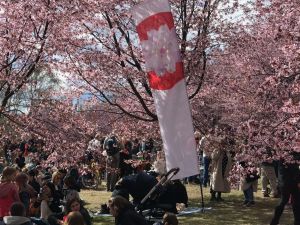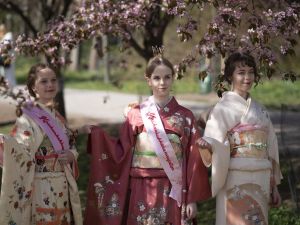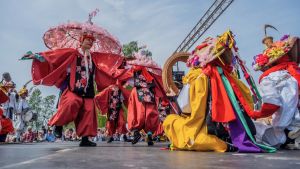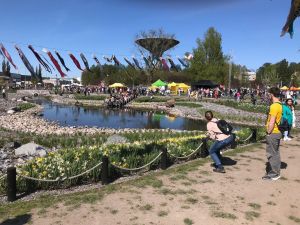Celebrating Hanami in Finland
| Celebrating Hanami in Finland | ||||
|---|---|---|---|---|
|

Practitioners and people who know the tradition well
Hanami (flower viewing) is a Japanese word describing a cultural practice of watching and appreciating flowers. At present, Hanami typically refers to the viewing of blooming cherry blossoms in the springtime, though it originally started with plum trees (Ume/梅).
Sakura (cherry blossoms) viewing Hanami in current Japanese territory supposedly started in the early 9th century among aristocrats and nobles. The practice became popular throughout Japan among the general public in the 17th century, merging between the peasant and aristocratic cultural practices. Today, Hanami can be interpreted as a cross-cultural and transnational practice where everyone (it does not matter which nation, culture or religion) appreciates and enjoys, mainly, blooming Sakura(s) such as in the United States, Germany, Sweden and Vietnam.
In Finland, the Roihuvuori Society holds the largest Hanami Festival in Finland, and has organized the event in the Roihuvuori Cherry Park and Japanese-style garden since 2008 with more than 450 cherry trees. The society has special connections to the Japanese Parliament and the Sakura Foundation (日本さくらの会), with mutual visits between the two organizations over the past several years.
In Finland, efforts such as Roihuvuori Park have made the general public aware of Sakura in spring and Hanami festivities. The Finnish Japanese Society (Suomalais-Japanilainen Yhdistys), founded in 1935, is a friendship association between Finland and Japan. Its purpose is to inspire interchange between Finnish and Japanese people and promote their mutual cultural understanding. This community has been actively involved in all meetings establishing the Roihuvuori Hanami event.
Many of Japan-related associations, such as Friends of Japanese Culture (Japanilaisen kulttuurin ystävät), Japanese Association in Finland (Suomen japanilaisten yhdistys), Japanese School Association in Helsinki (Helsingin japanilanen kouluyhdistys) contribute to the success of the festival.

Besides Roihuvuori, both Lappeenranta and Billnäs Ironworks Village have more than 300 cherry trees. The banks of Aurajoki in Turku are also filled with more than 200 cherry trees.
The City of Lahti established Cherry Park through the participatory budgeting campaign in 2020. Lahti has celebrated Hanami for two years and has plans to make it a yearly event. The city of Kerava is also known for its cherry trees. There are other cities that have Sakura parks, for example, Vihti, Kirkkonummi (Veikkola), Hausjärvi, etc. Hanami is celebrated in places like Pukkila and Porvoo as well.
There is no rule for how many cherry trees need to be at a location to practice Hanami. Even with one Sakura tree, people still enjoy Hanami.
Practising of the tradition
In Japan, Hanami today is typically understood as a festivity of viewing the blooming Sakura/Cherry blossoms (the most common kind in Japan is Someiyoshino) in early spring, including picnicking under and around the trees with family, friends, and often, for corporation employees as social events. It is a similar practice in Finland. Sakura(桜・さくら) represents ‘one of the most significant of Japanese aesthetic and popular culture symbols’. It is a ‘dominant poetic theme, as a symbol of the spring season and metaphor for the transitory nature of human life’. Sakura is also often seen as Japan’s national and cultural identity outside of Japan and gifted to foreign lands as symbols of diplomatic relationships and friendship.

In Japan’s folklore studies, the word Sakura is a combination of Sa and Kura, in which Sa is a mountain god who transforms itself into a god of rice fields in spring. Kura symbolizes a place that a god possesses. Therefore, Sakura trees were viewed as where the god lived in the early springtime. The mountain gods were also seen as ancestral spirits.
Nancy G. Hume noted in her book, Japanese Aesthetics and Culture, “Perhaps the greatest attraction of the cherry blossoms is not their intrinsic beauty but their perishability." Sakura blooms only for several days, and flowers scatter. Countless poets have lamented these scattering flower petals. It connects the Buddhist perspective of “impermanence of all things,” a significant worldview of classic to present-time Japanese arts. Today, popular culture, such as Japanese singer-songwriters, continue to produce Sakura-themed songs that are often the laments of lost love and separation but also of new beginnings.
Various kinds of Sakura trees are planted in Finland, such as “Sargent’s Cherry (Prunus sargentii), Accolade Cherry (Prunus’ Accolade’) and an ornamental cultivar from Hokkaido (Prunus sargentii’ Mustila’)” at the Lahti Cherry Park. Fourteen different varieties of cherry trees grow in Roihuvuori. The dominant varieties are Prunus sargentii and Prunus accolade, but among the Sato Sakura varieties most valued by the Japanese, Prunus serrulata P.’ Amanogawa’, ‘Kanzan’ and ‘Kiku-Shidare’ and Someiyoshino cherry trees grow in the Cherry Park.
The Hanami Festival at Roihuvuori Park has been organized in collaboration with the Japan Sakura Foundation with a Cherry Blossom Princess chosen to represent Finland each year.
The Japan Sakura Foundation was established by Japanese government officials to safeguard, appreciate, plant, and spread “Japanese” cherry blossoms in 1964. Amid high economic growth in Japan from the 1950s through the 1970s, along with a rapid national land development project and increased pollution, cherry blossoms throughout Japan had been abandoned and declined in numbers; this motivated some government officials to establish the foundation.
The foundation has also chosen a Sakura Queen every two years in Japan since 1966. The queens are symbolized as guardians of cherry blossoms, attending Sakura festivals throughout Japan, as well as taking roles as diplomatic representatives in international relations. Through the Embassy of Japan in Helsinki, the Sakura Foundation proposed that cherry blossom queens be chosen in Finland as well. With the Roihuvuori Society acting as the organizer, a sakura queen has been chosen at the Roihuvuori Hanami Festival since 2017. In addition, a cherry blossom princess was added from 2019 onward. The princess becomes the following year's queen. The queen and princess act as goodwill ambassadors between Finland and Japan. They have been invited to various events, including the Lahden kirsikkajuhla every year. Similarly to Finland, cherry blossom royals are chosen (collaboratioon with the the Japan Sakura Foundation) at the the National Cherry Blossom Festival in Washington D.C, USA, the Japanisches Kirschblütenfest in Hamburg, Germany, and Lễ hội hoa anh đào Nhật Bản in Hanoi, Vietnam.

The background and history of the tradition
In Finland, today’s Hanami was largely initiated by Mr Norio Tomida, who proposed to create a Sakura orchard for the Helsinki Public Works Department in 2005. This started other Japanese residents to donate the trees, spreading to some business corporations to join the project. Together with the City of Helsinki, 152 cherry blossoms were planted by the end of 2009 at Roihuvuori Park. The first Hanami Festival as a one-day event was held in May 2008, attended by about 250 people, and it became thousands to visit in 2012. It has continued to grow and the festival event has been visited by around 30,000 people annually. Including the event day, around 50,000 visitors visit Roihuvuori's parks during the flowering period. Many other cities and places other than Roihuvuori enjoy Hanami today.
About the history of Hanami in the context of Japan’s history, worship of the cherry blossoms already existed in the Jomon and Yayoi periods (about 13000 BCE to 300 CE). The trees were only seen in the mountains before. However, the best environment for Sakura to grow was in a secondary forest, meaning a regenerated forest after being cleared by humans or natural causes where it allows more sunlight. Therefore, Sakura trees grew best close to where humans lived, giving visible signs of spring arrival and agricultural cycle. As Sakura symbolized mountain god and ancestor spirits, people incorporated cherry blossoms into their cultural practices.
After the introduction of Chinese Poetry (漢詩) in the 6th to 8th century, cherry blossoms started appearing in poems. There is also a record of planting a tree in a noble’s house-yard, both appreciating its beauty and guarding the direction of west and north, which was considered sacred. In this era, cherry blossoms started to be domesticated and symbolized as youthful spirits of the land to prevent epidemics and suppress evil spirits.
The question of where the original places of Cherry blossoms are, has been debated over the years. Forestry scholar, Toshio Katsuki explains that there are about 10 species of wild Sakura trees in Japan, but many others exist throughout the globe. Xianrong Wang adds that Sakura is not a single species but a generic botanical term for plants in the Sakura genus of the rose family, and about 150 species of wild Sakuras exist in the world. The history of the earth’s movements and climate changes make Sakura’s origin undefinable to a single location but in various places. Countless Sakura species have naturally and artificially hybridized over the years. Someiyoshino was produced by mating two different cherry blossoms in the Edo period (1063-1868) in Japan, becoming the most common Sakura trees in Japan today.
From the known records today in Japan, the Heian period (8th to 12th century) is often considered the origin of Hanami festivity with cherry blossoms, which the Emperor Saga first held in 812 CE, becoming an annual festival. Hanami was also held at grand Buddhist temples outside the royal palace or nobles’ mansions. This event became a place for writing poetry, which was a significant political activity, showing the wealth and power of the emperor and nobles. At the same time, cherry blossoms became a symbol of love and evanescence.
During the warrior’s eras of Kamakura, Muromachi and Azuchi/Momoyama periods (between the 12th to the end of the 16th century), cherry blossoms’ domestication spread outside of the cities, enjoyed by samurai class households. The significant popularization of Hanami happened in the Edo period (1603-1868) when the general public became more powerful than before. An agricultural ritual with Sakura trees by peasants and the hanami festivity of aristocrats were merged, becoming the Hanami festivity, we know today. Gardening became a trend in this period, and various types of cherry blossoms were produced in the Edo period, including Someiyoshino. Through the domestication and organized planting of the trees, some places became famous for Sakuras and Hanami spots in spring.
The transmission of the tradition
In Japan, Hanami ‘remains a quintessential pastime’ with news on the state of the blossoms (when they start and when they will be in full bloom). Families, friends and corporate employees enjoy picnics under blooming Sakuras.
Planting, growing and managing cherry trees are heritage themselves, co-living with human communities and natural things. For example, Sakura trees were planted alongside large rivers and on the river banks to prevent floods in the Edo period. Cherry trees were also planted in an organised way in rural areas in the same period, and it encouraged city people to travel and benefited rural communities with tourism. This created the marginalisation of people and culture between rural and city areas. Organised planting created further the hybridisation between human living space and nature.
Thousands of Sakura were planted in the regions affected by the 2011 Tōhoku Earthquake and Tsunami as a symbol of lesson, resilience and hope for those who survived, and memorials to those who lost lives.
As seen at the Roihuvuori festival, the Hanami event has become a larger Japanese cultural heritage celebration than simply enjoying cherry flowers. At the festival, other Japanese heritage practices (older to contemporary) are seen and enjoyed, such as Kimono, Yukata, Cosplay (people dressed up like Anime characters), Obanyaki/Imagawayaki (a popular street snack: stuffed pancake with sweet azuki bean paste), ParaPara dancing (a synchronized dance became popular in the 90s) and, recently, Koinobori, giant carp kites that are placed for May 5th, a Child's Day for good health and wellbeing. Japanese dog breeds, such as Akita and Shiba, are also photographed under the blooming Sakura trees.
Including the collaboration with the Japan Sakura Foundation and the continuation of selecting Sakura Queen and Princess at Roihuvuori’s festival, other cities, parks and organisations in Finland also continue to promote Sakura and Hanami. Therefore, this cultural practice is expected to continue and grow, becoming Finland's own living heritage that is not limited to any cultural, religious and social backgrounds.
The future of the tradition
The practice of today’s Hanami is not limited to Japan. However, many other nations, including Finland, often introduce other Japanese cultures at a Hanami event, such as anime and food. Blooming Sakuras that typically indicate the arrival of spring are highly visible, which makes it easier to hold Hanami as an annual event, therefore becoming a new tradition/heritage in the respected communities and countries.
Also, Sakura and Hanami festivals are highly commercialised and commodified today. The prediction and status of when the trees blossom is reported on the daily news in March and April in Japan (May in Finland). Various corporations, such as Coca-Cola, Starbucks and Asahi, have produced limited editions of Sakura-themed products around this time.
As mentioned above, the Hanami Festival at Roihuvuori in Finland has become a celebration of Japanese culture in a larger context in which other tangible and intangible heritage elements are brought in, becoming a special Hanami festival heritage itself. At the same time, Hanami and Hanami festivals are familiar annual customs for immigrants from Japan, who can continue to enjoy springtime with Sakura in a foreign land.
Evident with many places that enjoy Sakura trees in Finland, as well as the City of Lahti's newly established Cherry Park and the start of the hanami festival, the Hamami culture in Finland has been growing, and more and more people have practised it in their ways. There are no apparent rules for Hanami, but to enjoy the beauty and melancholy as flowers last less than a week.
Hanami is an excellent example of Finland and Japan's shared admiration and respect for natural things and their beauty. The culture of Hanami could have been naturally adopted into the context of Finland, and more and more people participate in this transnational and transcultural heritage practice.
The communities behind this submission
Roihuvuori-Seura ry: https://kaupunginosat.fi/roihuvuori/roihuvuori-seura/
Suomalais-Japanilainen Yhdistys ry: https://suomi-japani.net/
Japanilaisen Kulttuurin Ystävät: http://japaninkulttuuri.net/
Bibliography and links to external sources of information
VIDEOS
Library of Congress. “Cherry Blossom Viewing over the Centuries: Cherry Blossoms in Japanese Culture”. https://www.youtube.com/watch?v=URElx9A-0nk
WEBSITES
City of Lahti.”Cherry Park”. https://www.lahti.fi/en/leisure-and-sports/cherry-park/
City of Helsinki. “Kirsikkapuisto Cherry Park, Sakura Park”. https://vihreatsylit.fi/en/kirsikkapuisto/
City of Turku. “Aurajoen kirsikkapuita tullaan katsomaan kauempaakin” . https://www.turku.fi/uutinen/2021-05-11_aurajoen-kirsikkapuita-tullaan-katsomaan-kauempaakin
Docomo. (2022) “One year from now, and 100 years more being with your loved ones.” A hope entrusted to 17,000 cherry trees”. https://rainbow.nttdocomo.co.jp/tohoku/know/110017000.html
Environmentally Symbiotic Housing Promotion Council. (2023) “Learning from ‘Sakura’”. https://www.kkj.or.jp/contents/event/landscape/landscape01.html
Go Tokyo: The Official Tokyo Travel Guide. “Sakura- where, when, and how to enjoy Japanese cherry blossoms”. https://www.gotokyo.org/en/story/guide/the-japanese-cherry-blossom-trees/index.html
Good Luck Trip (2023). “What Sakura means to Japanese?: Its History and Trivia”. https://www.gltjp.com/ja/article/item/20271/#:~:text=%E9%8E%8C%E5%80%89%E6%99%82%E4%BB%A3%E3%81%BE%E3%81%A7%E3%81%AF%E6%94%BF%E6%B2%BB,%E3%81%A8%E8%80%83%E3%81%88%E3%82%89%E3%82%8C%E3%81%A6%E3%81%84%E3%81%BE%E3%81%99%E3%80%82
Japan Sakura Foundation.https://www.sakuranokai.or.jp/queen/ Library of Congress, “Sakura: Cherry Blossoms as Living Symbols of Friendship”. https://www.loc.gov/exhibits/cherry-blossoms/cherry-blossoms-in-japanese-cultural-history.html
Sora News 24. “Coca-Cola Japan unveils new sakura design bottle for cherry blossom season 2019”. https://soranews24.com/2019/01/18/coca-cola-japan-unveils-new-sakura-design-bottle-for-cherry-blossom-season-2019/
The Gyaru Wiki. “Para Para”. Accessed on 2 October 2023. https://gyaru-109.fandom.com/wiki/Para_Para
Visit Raseborg. “Flowery Raseborg”. https://www.visitraseborg.com/en/flowery-raseborg/
ONLINE ARTICLES
Finland, Naturally Experiences. “Billnäs Ironworks Village is Becoming Finland’s Hanami Paradise – Walk There along Åvallen Route from the Beautiful Pumpviken Park” (May 29 2023) https://finlandnaturally.com/finnish-culture-food-heritage/billnas-ironworks-village-is-becoming-finlands-hanami-paradise-walk-there-along-the-jokivalli-route-from-the-beautiful-pumpviken-park/
Kobayashi, Mariko. 2023. “A Japanese Popular Street Snack ‘Obanyaki’ Enjoyed by all generations!”. Globalkitchen Japan (March 2023), https://www.globalkitchenjapan.com/blogs/articles/enjoyed-by-all-generations-a-japanese-popular-street-snack-obanyaki#:~:text=Obanyaki%20is%20a%20round%20disc,that%20children%20enjoyed%20back%20then.
Smithsonian Folklife Festival. “Significance of Sakura: Cherry Blossom Traditions in Japan”. https://festival.si.edu/blog/2014/significance-of-sakura-cherry-blossom-traditions-in-japan/
Wang, Xianrong, (translated by Kawaziri). 2021. サクラの原産地は中国か日本か、実は…―中国メディア [Is the origin of Sakura in China or Japan? In fact…Chinese Media] Record China (March 2021) https://www.recordchina.co.jp/b873845-s25-c30-d0193.html
OTHER SOURCES
Arioka, Toshiyuki. 2007. 桜1:ものと人間の文化史 [Sakura I: Cultural History of Things and Humans]. Tokyo: Hosei University Press. Buckley, Sandra. 2006. Encyclopedia of Contemporary Japanese Culture. Routledge.
Furuichi, Mami. 2010. Master Thesis, Study on Socio-Cultural History of Cherry Blossom and Ume Blossom: Focusing on Showplaces of Flower around Edo City of the Edo Period. Tokyo University Graduate School of Frontier Science.
Granlund, Taila. 2018. Master Thesis, Hana yori Dango: Flower Viewing in Japan as a Secularized Ritual of Lived Religion. Faculty of Theology, University of Helsinki.
Hualei, Xiong. 2015. 博士論文:地域社会の視点から見た花見のリアリティー鹿児島県伊佐氏大口の事例よりー [Doctoral Thesis, The Reality of Cherry Blossom Viewing from the Viewpoint of Regional Society: A Case Study of Okuchi in Isa City, Kagoshima Prefecture]. Kagoshima University Graduate School of HUmanities and Social Sciences. Hume, Nancy G. 1995. Japanese Aesthetics and Culture. NY: State University of New York Press.
Katsuki, Toshio. 2017. Taxonomy and identification by morphology for Japanese flowering cherries. Tree and Forest Health 21, 93~104. Nagumo, Masayuki. 2011. “The Second Studies of Sakura: Focusing on Hanami”. Kōhyō 48(3), 76-83.
Sakurai, Mitsuru, 1961. Makura-Kotoba and Junō: The Creation of “Hana-Chirafu” and “Miyuki-Furu”. Manyō 40, 32-40.
